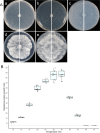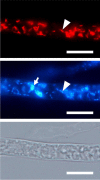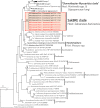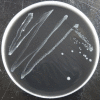Detection and isolation of a new member of Burkholderiaceae-related endofungal bacteria from Saksenaea boninensis sp. nov., a new thermotolerant fungus in Mucorales
- PMID: 37996922
- PMCID: PMC10666400
- DOI: 10.1186/s43008-023-00129-2
Detection and isolation of a new member of Burkholderiaceae-related endofungal bacteria from Saksenaea boninensis sp. nov., a new thermotolerant fungus in Mucorales
Abstract
Thermotolerance in Mucorales (Mucoromycotina) is one of the factors to be opportunistic pathogens, causing mucormycosis. Among thermotolerant mucoralean fungi, Burkholderiaceae-related endobacteria (BRE) are rarely found and the known range of hosts is limited to Rhizopus spp. The phylogenetic divergence of BRE has recently expanded in other fungal groups such as Mortierellaceae spp. (Mortierellomycotina); however, it remains unexplored in Mucorales. Here, we found a thermotolerant mucoralean fungus obtained from a litter sample collected from Haha-jima Island in the Ogasawara (Bonin) Islands, Japan. The fungus was morphologically, phylogenetically, and physiologically characterized and proposed as a new species, Saksenaea boninensis sp. nov. Besides the fungal taxonomy, we also found the presence of BRE in isolates of this species by diagnostic PCR amplification of the 16S rRNA gene from mycelia, fluorescence microscopic observations, and isolation of the bacterium in pure culture. Phylogenetic analysis of the 16S rRNA gene of BRE revealed that it is distinct from all known BRE. The discovery of a culturable BRE lineage in the genus Saksenaea will add new insight into the evolutional origin of mucoralean fungus-BRE associations and emphasize the need to pay more attention to endofungal bacteria potentially associated with isolates of thermotolerant mucoralean fungi causing mucormycosis.
Keywords: Endohyphal bacteria; Mucormycosis; Mucoromycotina; One new taxon; Opportunistic pathogens; Saksenaeaceae; Thermotolerant fungi.
© 2023. The Author(s).
Conflict of interest statement
The authors declare that they have no competing interests.
Figures







Similar articles
-
Prevalence and Intra-Family Phylogenetic Divergence of Burkholderiaceae-Related Endobacteria Associated with Species of Mortierella.Microbes Environ. 2018 Dec 28;33(4):417-427. doi: 10.1264/jsme2.ME18081. Epub 2018 Dec 8. Microbes Environ. 2018. PMID: 30531154 Free PMC article.
-
New Endohyphal Relationships between Mucoromycota and Burkholderiaceae Representatives.Appl Environ Microbiol. 2021 Mar 11;87(7):e02707-20. doi: 10.1128/AEM.02707-20. Print 2021 Mar 11. Appl Environ Microbiol. 2021. PMID: 33483310 Free PMC article.
-
Saksenaea erythrospora, an emerging mucoralean fungus causing severe necrotizing skin and soft tissue infections - a study from a tertiary care hospital in north India.Infect Dis (Lond). 2017 Mar;49(3):170-177. doi: 10.1080/23744235.2016.1239027. Epub 2016 Oct 4. Infect Dis (Lond). 2017. PMID: 27701965
-
Outbreaks of Mucorales and the Species Involved.Mycopathologia. 2020 Oct;185(5):765-781. doi: 10.1007/s11046-019-00403-1. Epub 2019 Nov 16. Mycopathologia. 2020. PMID: 31734800 Review.
-
Pathogenicity patterns of mucormycosis: epidemiology, interaction with immune cells and virulence factors.Med Mycol. 2019 Apr 1;57(Supplement_2):S245-S256. doi: 10.1093/mmy/myz011. Med Mycol. 2019. PMID: 30816980 Free PMC article. Review.
References
-
- Alvarez E, Garcia-Hermoso D, Sutton DA, Cano JF, Stchigel AM, Hoinard D, Fothergill AW, Rinaldi MG, Dromer F, Guarro J. Molecular phylogeny and proposal of two new species of the emerging pathogenic fungus Saksenaea. J Clin Microbiol. 2010;48:4410–4416. doi: 10.1128/JCM.01646-10. - DOI - PMC - PubMed
Grants and funding
LinkOut - more resources
Full Text Sources
Research Materials
Miscellaneous
